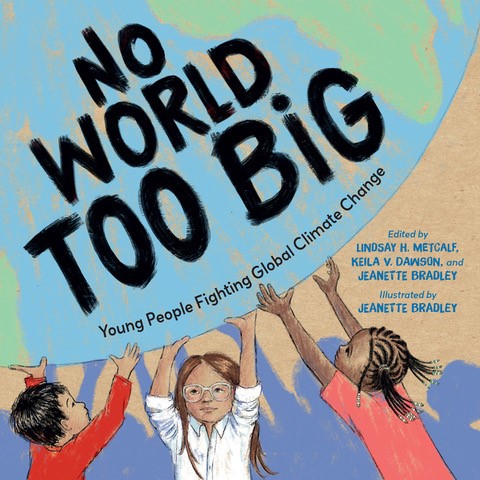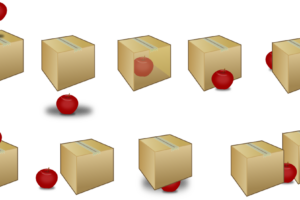GUEST BLOGGER LINDSAY H. METCALF
Students today will be living with the climate of tomorrow. The best way to counteract the climate crisis is to scale up how we think about mitigation, moving from individual to collective action—from “me to we.” But how do we do that? Start with your school’s energy consumption.
Connecting local energy usage to climate
Students may know that global warming is caused by the burning of fossil fuels, which releases greenhouse gases like carbon dioxide and methane into the atmosphere. But do they understand how their school fits into the equation? Schools represent accessible communities where students have potential to enact change that makes a real impact.
Begin this lesson by reading the poem “Mackintosh Academy: Capture the Sun” by Heidi E. Y. Stemple from No World Too Big: Young People Fighting Global Climate Change (Charlesbridge, March 14, 2023). Then use the following questions to open up discussion.
- What do you know about the term, “climate footprint”?
- What do you know about fossil fuels? About renewable energy?
- Explain how converting to renewable energy sources helps fight the climate crisis.
- Why do you think Mackintosh Academy students chose to pursue solar panels as a way of reducing their school’s climate footprint?
- What steps might the students have taken to achieve their goal?
- How does the solar panel project fit in with the school motto, “Keen minds. Compassionate hearts. Global action”?
Conduct an energy audit of your school
Now have students apply their knowledge of energy usage and sources to their own school building.
Objective
Working together, students will conduct an energy audit in the style of a scavenger hunt to determine how energy is used in their school as well as identify opportunities to conserve energy or convert to renewable sources of power.
Materials
- Interview questions worksheet
- Baseline audit worksheets (Grades K-2; Grades 3-5)
- Energy conservation worksheet (elementary school; middle school)
- Common wattage reference sheet
- School map (indoor and outdoor)
- Lumen meter (optional)
- Post-action audit worksheets (Grades K-2; Grades 3-5)
Vocabulary
- Fossil fuel
- Renewable energy
- Greenhouse gas
- Conservation
- Climate footprint
- Energy vampire
- Solar energy
- Hydropower
- Geothermal energy
- Wind energy
Procedure
Before students begin the audit, divide the class in two. Have half the students role-play appropriate behavior for conducting an energy audit in classrooms, common areas, outdoor spaces, and in the school’s offices. Have the other half of the class role-play inappropriate behaviors. After these demonstrations, discuss as a class.
Invite parents and community experts to participate in the energy audit. Divide the class into teams, each accompanied by an adult.
Divide the school into sections according to the number of teams. Provide maps highlighted with each team’s assigned section. Assign one team to interview a school administrator using the interview questions worksheet.
Send student teams out to conduct the energy audit using the baseline audit worksheets as a guide.
Afterward, break students into their assigned teams and have them discuss predictions based on their findings.
Now the class will combine their data to create recommendations for next steps. Lead the students to create a comprehensive picture of the school’s energy usage. Complete the Energy Conservation worksheet as a class, then create graphs and a class slideshow.
Have students nominate team captains. Invite school administrators and community leaders to a presentation by the team captains of the class’s findings and recommendations for improvement.
Finally, repeat the audit several months later using the post-action audit worksheets. Evaluate the results and communicate them with administrators and the wider school community.
Adapted from National Wildlife Federation’s Eco Schools USA Pathways
Featured image credit: “Light bulbs” by Spigoo is licensed under CC BY 2.0.
Lindsay H. Metcalf is a journalist-turned-award-winning author of nonfiction picture books: Beatrix Potter, Scientist, a Mighty Girl Best Book of 2020 and Young People’s Literature Award winner from the Friends of American Writers Chicago; Farmers Unite! Planting a Protest for Fair Prices, a Kansas Notable Book, Friends of American Writers honoree, NCSS/CBC Notable Social Studies Trade Book, and Junior Library Guild selection; and No Voice Too Small: Fourteen Young Americans Making History, a Kirkus and Chicago Public Library Best Book, Notable Social Studies Trade Book, and NCTE Notable Poetry Book. Her latest book is No World Too Big: Young People Fighting Global Climate Change (Charlesbridge, spring 2023), a poetry anthology from the team behind No Voice Too Small. Lindsay lives in Kansas with her husband, two sons, and a menagerie of pets. Learn more at lindsayhmetcalf.com and @lindsayhmetcalf on Twitter and Instagram.











Leave a Reply
Your email is safe with me.